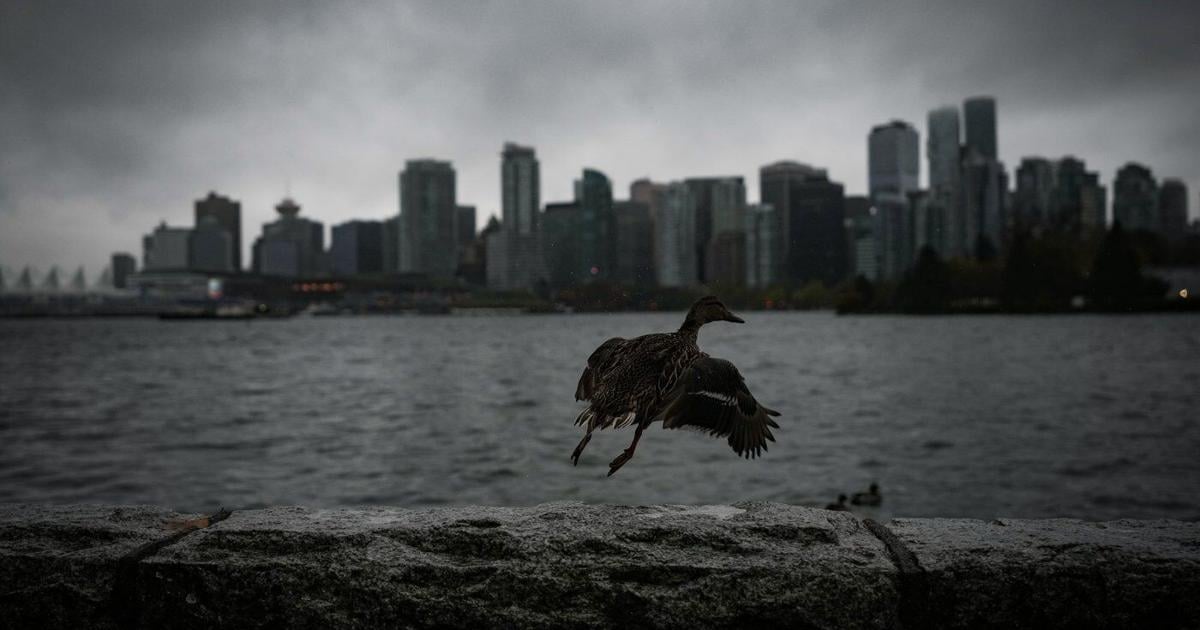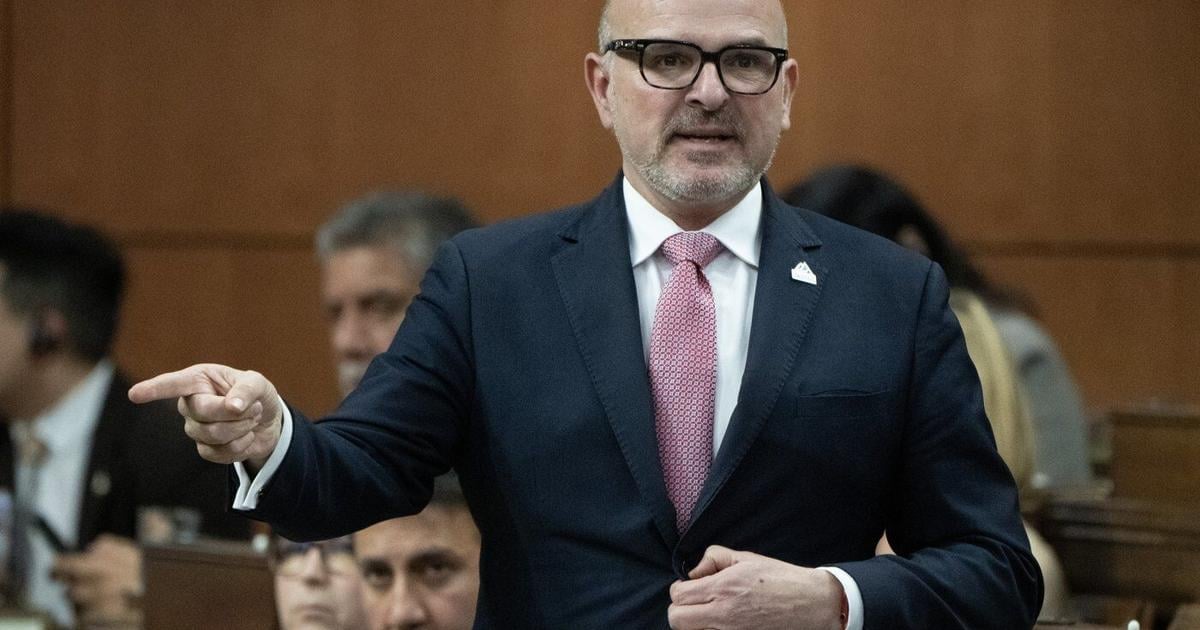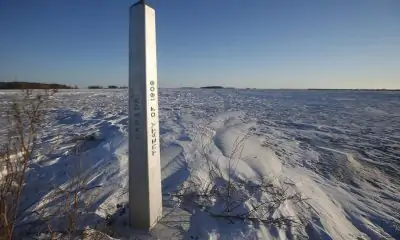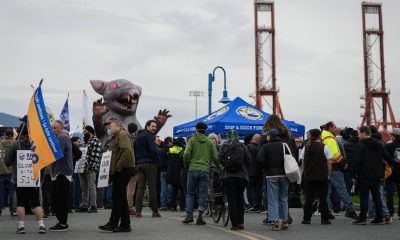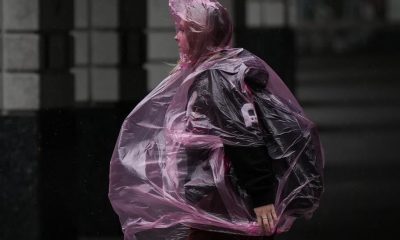VANCOUVER – Geoff Johnson and fellow storm watchers in Ucluelet, B.C., were concerned on Tuesday about the so-called “bomb cyclone” taking shape off Vancouver Island — not for safety reasons, but because they wondered if it would be “disappointing.”
Winds had been light throughout the day. But they need not have worried about any lack of drama as night fell, and the howling winds were punctuated by the sound of trees snapping “like gunshots.”
“Last night, around 8 o’clock, a tree fell on my friend’s boat, narrowly missing the RV that he lives in,” said Johnson on Wednesday. “I know another friend’s car was completely crushed by a fallen tree overnight.
“I’m actually standing in a house that had a large tree in its yard that luckily fell (in) the other direction, across the neighbour’s driveway instead of onto their second storey,” said Johnson, a weather enthusiast who runs the YouTube channel UkeeTube.
The massive storm battered parts of coastal British Columbia with winds up to 170 km/h, equivalent to a Category 2 hurricane. A bomb cyclone is caused by rapidly dropping atmospheric pressure at the centre of a weather system.
More than 200,000 homes and businesses were plunged into darkness as the winds and downed trees brought down power lines.
Ted Olynyk, BC Hydro’s manager of community relations for Vancouver Island, said winds in Nanaimo were unlike anything he had experienced in the area before.
“And we know as a result of climate change unfortunately, we’re going to get more storms — and they’re going to be more intense like this,” he added.
The BC Hydro outage map showed about 75,000 customers remained without power on Wednesday afternoon, mostly on Vancouver Island.
A wind warning remained in effect for the west coast of Vancouver Island, where gusts were expected to weaken overnight as the storm system — located about 500 kilometres off the coast — moved north.
Environment Canada data show remote Sartine Island, off the northern tip of Vancouver Island, was hit by the most powerful gusts late Tuesday, recording the storm’s top wind speed of 170 km/h.
But gusts of more than 100 km/h were still being recorded on Wednesday at several northern and central weather stations.
In Metro Vancouver, winds peaked at 87 km/h at the Tsawwassen ferry terminal.
While just one location set a new record for wind speed — the Port Hardy Airport, which recorded winds of 122 km/h at their peak — Environment Canada meteorologist Brian Proctor said wind records are difficult to compare historically, and the power outages demonstrate the severity of the weather event.
“I think one of the things to emphasize with this system is we were somewhat lucky for coastal British Columbia with this system and the track it took,” Proctor said.
“If it was closer to Vancouver Island, a lot of those really super strong winds might have been hitting and impacting some of our more populated areas — we think about the east side of Vancouver Island, Greater Victoria, Metro Vancouver.”
Johnson said he was not aware of any injuries among his friends in Ucluelet or nearby Tofino, but they remained without power on Wednesday. He said he would be surprised to see the lights come back on before Friday given the severity of the storm and the high number of trees it knocked over in the area.
“We heard a few of them, and they almost sounded like gunshots from a distance last night,” Johnson said of the trees snapping under the strong winds.
“Our friend with the RV, he was actually inside it at the time and thought that the wind was ripping the side off of the RV at first,” he said.
About 270,000 BC Hydro customers were without power at the peak of the storm.
BC Hydro crews have made significant progress addressing the outages, but Olynyk said ongoing winds pose challenges. He asked those without power to be patient, report downed lines and stay far away from any damaged infrastructure.
“We’ll have crews out there,” he said, adding they were working through “harrowing” conditions. “But at the bottom line, we’re not putting crews out where it’s going to be dangerous for them — if there’s big branches coming down (or) a potential for trees just to fail while they’re working.”
B.C.’s Transportation Ministry said multiple highways on Vancouver Island were closed Wednesday because of downed power lines, fallen trees and debris.
BC Ferries cancelled morning sailings on its major routes again Wednesday morning due to high winds, citing safety concerns for crew and passengers. It said conditions had since improved on some routes, enough to restart services on the Tsawwassen-Swartz Bay route between Metro Vancouver and Greater Victoria.
The ferry operator had cancelled numerous sailings Tuesday between Vancouver Island and the Lower Mainland.
An advisory from Environment Canada said the storm was expected to remain offshore but “curl northward,” bringing strong winds to the north and central coast.
The weather office said winds would gradually ease throughout Thursday as the low pressure system weakens and moves farther offshore.
The office had previously warned that elevated ocean levels combined with significant wind and waves would push water levels to exceed the “highest astronomical tide” for parts of the south coast during Wednesday’s high tide.
The storm also wreaked damage south of the border as it swept over the northwestern United States, causing widespread power outages.
In Washington state, South County Fire said on social media that a woman died Tuesday night when a large tree fell on a homeless encampment in Lynnwood.
The Seattle Fire Department also reported that a tree fell on a vehicle Tuesday, temporarily trapping someone inside, but later confirmed the person was in stable condition after being extricated.
— With files from Brieanna Charlebois and The Associated Press
This report by The Canadian Press was first published Nov. 20, 2024.

